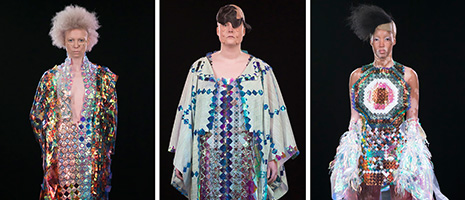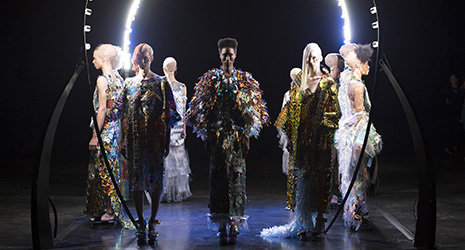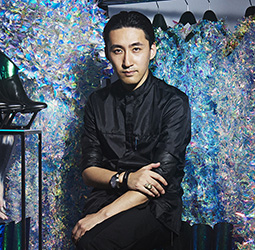Home > Highlighting JAPAN > Highlighting Japan March 2017 > Innovative Artists
Highlighting JAPAN


Haute Couture for All
Fashion designer Yuima Nakazato makes use of advanced production and textile technologies with a view to one day achieving the concept of “mass customization.”
Born in 1985 in Tokyo, Yuima Nakazato is an up-and-coming Japanese designer who is attracting attention in the global fashion industry. When still a mere 30 years old, he was chosen as the official guest designer for the Paris Haute Couture Fall-Winter Collection held in July 2016, only the second Japanese designer in history to present at the event since Hanae Mori twelve years ago. Nakazato also participated in the Spring-Summer Collection the following year in 2017, where he wowed the fashion world with creations that utilized cutting-edge technology.
Born to a sculptor father and engraver mother, Nakazato was raised from a young age surrounded by various forms of artistic expression, including classical performing arts and contemporary art. When he was in senior high school, he says he used to buy secondhand clothing and rework it to express his individuality. He first learnt of the Royal Academy of Fine Arts Antwerp in Belgium when he happened to see it in a newspaper and felt irresistibly drawn to it. In 2004, the same year he graduated from senior high school, he entered the fashion department of the Academy without hesitation.
“When I took cutting-edge materials that I had obtained in Japan to the lessons, such as film and materials that change color with temperature, everyone was amazed, including the teacher,” says Nakazato. “I realized intuitively from that time that these Japanese materials would become my tools.”
In 2008, he received the Innovation Award from international designer Ann Demeulemeester for his graduation piece that introduced the idea of origami, in which a dress changes into a three-dimensional sculptural piece when opened out. Shoes that he designed when he was a student are preserved in perpetuity in the MoMu Fashion Museum Antwerp.
When he approached Demeulemeester to sound out the possibility of working under her, she replied, “I gave you the prize because I was struck by the originality of your work, but surely your life itself is innovative?”
Emboldened by these words, Nakazato launched his own fashion label, YUIMA NAKAZATO, in 2009 and started down an unknown path.
Results were immediate. Firstly, an order came in from the stylist of The Black Eyed Peas female vocalist, Fergie, who had seen his graduation piece on the Internet and wanted him to design a costume for the band’s World Tour. A succession of orders followed, including a costume for Lady Gaga’s performance in Japan, as well as costumes for a popular Japanese dance group and for movies and theater, eventually leading to his decision to challenge himself in the realm of haute couture.
“Haute couture is the epitome of made-to-order garments, but only a very few people are able to wear them,” says Nakazato. “However, if we introduce various state-of-the-art technologies, there is the potential for anyone to enjoy made-to-order clothing at relatively low cost. I think this is the ideal for mankind’s clothing.”
When producing his designs, Nakazato adopts state-of-the-art machines such as 3D printers and cutting plotters. Rather than going from fabric to pattern production, he has come up with a completely new process for creating the finished garment. A major feature is the frequent use of holographic film material that changes color with the light.
The Haute Couture Fall-Winter 2016 Collection was a representation of the change of colors of natural phenomena such as sky, sea and auroras, on the theme of UNKNOWN. Rather than sewing together the cut parts, these were fixed in place using metal fittings, creating a variety of forms. The theme of this year’s Spring-Summer Collection, which will be his second, is the Latin IGNIS AER AQUA TERRA (FIRE WIND WATER EARTH). The surface of each part is slightly uneven, akin to male and female screws. These fit together to anchor the parts in place, and allow the parts to be attached and removed. A total of twelve different iridescent costumes assembled by combining a variety of parts created a huge sensation.
“This time was an experimental attempt to produce ‘unit constructed textiles’ that overturn the concept of clothes with a view to achieving mass customization. The system reflects a new idea of making clothes that fit any body shape as desired,” says Nakazato. “Utilizing this system, I would like to release as soon as possible ready-to-wear clothes that can be ordered from anywhere in the world. And in order to showcase the process of updating the system, I would like to continue to participate in haute couture for the next few years.”
© 2009 Cabinet Office, Government of Japan







